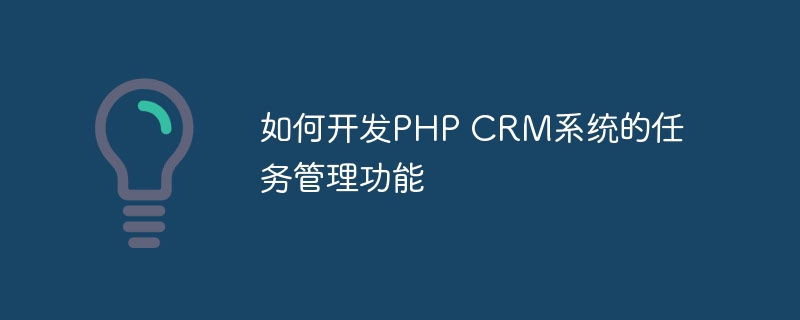
How to develop the task management function of PHP CRM system
In the current information age, enterprises and organizations increasingly need an efficient customer relationship management (CRM) system to help manage tasks and increase productivity. Task management is a vital part of the CRM system. It can help companies and organizations better organize, allocate and track tasks, and improve the team's work collaboration ability and customer service quality. This article will introduce how to develop the task management function of PHP CRM system.
1. Requirements Analysis
Before developing the task management function, it is necessary to conduct a requirements analysis to clarify the specific functions and requirements of the system. The following are some basic requirements for the task management function:
- Create tasks: Users can create new tasks and specify the person in charge, deadline, priority and other information of the task.
- View task list: Users can view the list of all tasks, including basic information and status of the tasks.
- Assign tasks: Administrators can assign tasks to the corresponding person in charge, and also need to support the function of transferring and sharing tasks.
- Complete the task: The person in charge can mark the task as completed and fill in the task execution status and notes.
- Reminder function: The system can automatically send reminder notifications to the person in charge of the task to ensure that the task is completed on time.
- Search and sort: Users can search by keywords and sort tasks according to different criteria, making it easy to quickly locate tasks.
2. Database design
The implementation of the task management function requires the design of a corresponding database structure to store task-related information. A simple task table includes the following fields:
- Task ID: The unique identification of the task.
- Title: A brief description of the task.
- Content: Detailed description of the task.
- Responsible person ID: The person in charge of the task.
- Deadline: The deadline for the task.
- Priority: the urgency of the task.
- Status: The current status of the task, such as in progress, completed, etc.
- Creation time: The creation time of the task.
By creating task tables and user tables, establishing the association between task tables and user tables, and realizing task allocation and tracking.
3. Implementation of task management function
- Create tasks: On the system interface, a form is provided in which basic information about the task can be entered. After the user fills in the form, click " Create" button to store the task information in the database.
- View task list: On the system interface, display a list of all tasks, including basic information and status of the tasks. By querying the database, obtain task information and dynamically generate a task list.
- Assign tasks: The administrator selects the task in the task list, clicks the "Assign" button, selects the person in charge who needs to be assigned, assigns the task to the designated person in charge, and saves the assignment information to the database.
- Complete the task: The person in charge selects the task in the task list, clicks the "Complete" button, marks the task as completed, and fills in the execution status and remarks. Update the status and related information of the task.
- Reminder function: Set a scheduled task, regularly check the task deadline and status in the system, and generate corresponding reminder notifications according to the set rules and send them to the person in charge.
- Search and sort: A search box and sorting options are provided on the task list page. Users can search for tasks by entering keywords, or click the sorting option to sort tasks and update the task list to display results.
4. System Optimization and Expansion
- Response speed optimization: paging the task list, limiting the number of tasks displayed on each page, and reducing page data through paging loading loading time.
- Permission control: Based on user roles and permissions, perform access control and operation control on task management functions to ensure system security.
- Data backup and recovery: Perform regular data backups to prevent data loss and enable timely data recovery in the event of system failure.
- Task statistics and reports: Add task statistics and report functions to the system to perform statistics and analysis on task completion status, workload of the person in charge, etc., to provide a reference for decision-making.
To sum up, how to develop the task management function of the PHP CRM system needs to be comprehensively considered from the aspects of demand analysis, database design, function implementation, etc., to ensure that the system can meet the needs of users and improve work efficiency. Through continuous optimization and expansion, the system can be made more stable, secure and efficient.
The above is the detailed content of How to develop the task management function of PHP CRM system. For more information, please follow other related articles on the PHP Chinese website!

